SCOTLAND-1
(Last updated 2/5/05)
Overview of the city of Stirling (left),
north of Glasgow on the eastern route to the Highlands; the 220
ft high Wallace Monument towers over the Forth River valley (the
Carse of Stirling) atop Abbey Craig, just north of the city, with
the mountains of the Trossachs forming a backdrop; the Monument
commemorates the victory of the Scots, led by William Wallace
("Braveheart"), over the English (led by Edward I) at
Stirling Bridge in 1297. Statue of Robert the Bruce (right), at
the top of Castle Rock, a volcanic bluff on the south side of
the city; Bruce led the Scots to their greatest and most decisive
victory over the English during the Scottish Wars of Independence,
annihilating a much larger army (led by Edward II) at Bannockburn
(now a southern suburb) on June 24, 1314, and, for all intents
and purposes, freeing Scotland - although it took another 14 years
for the English to formally acknowledge the fact.
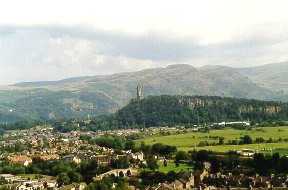
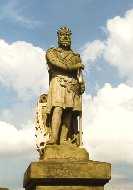 Stirling Castle, among the grandest
of all Scottish castles, and probably the most strategically important,
a royal stronghold since the 12th century, although most of the
present buildings are from the 15th and 16th c., with artillery
fortifications from the 16th and 18th c. Stirling was home to
Alexander I (12th c.), William the Lion (13th c.), site of the
murder of William 8th, Earl of Douglas, by James II (in 1452),
and the birthplace of James III (in 1451). It served as the seat
of the royal court of Stewart Scotland from the reign of James
IV through Mary, Queen of Scots (crowned here in 1543, at the
age of 9 months), to James VI, the first King of both Scotland
and England (brought here for refuge at the age of 2 months).
Stirling Castle, among the grandest
of all Scottish castles, and probably the most strategically important,
a royal stronghold since the 12th century, although most of the
present buildings are from the 15th and 16th c., with artillery
fortifications from the 16th and 18th c. Stirling was home to
Alexander I (12th c.), William the Lion (13th c.), site of the
murder of William 8th, Earl of Douglas, by James II (in 1452),
and the birthplace of James III (in 1451). It served as the seat
of the royal court of Stewart Scotland from the reign of James
IV through Mary, Queen of Scots (crowned here in 1543, at the
age of 9 months), to James VI, the first King of both Scotland
and England (brought here for refuge at the age of 2 months).
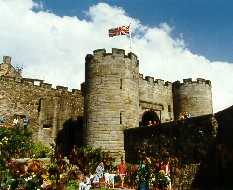
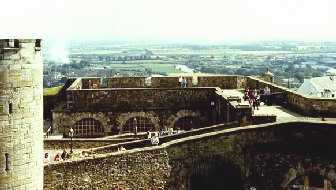 Loch Lomond (left), Scotland's largest
and longest freshwater lake, near the Highland Boundary Fault,
a geological rift - marked by a narrowing and bending of the Loch
- that divides Scotland diagonally from southwest to northeast,
and separates Scots into Lowlanders and Highlanders. A view west
down Glen Kinglas (right), after climbing steeply up through Glen
Croe and the Argyll Forest to the summit of "Rest and Be
Thankful" Pass (from the 1880's; the spot where 2nd and 3rd
class passengers could get back in the coach after pushing it
up the hill).
Loch Lomond (left), Scotland's largest
and longest freshwater lake, near the Highland Boundary Fault,
a geological rift - marked by a narrowing and bending of the Loch
- that divides Scotland diagonally from southwest to northeast,
and separates Scots into Lowlanders and Highlanders. A view west
down Glen Kinglas (right), after climbing steeply up through Glen
Croe and the Argyll Forest to the summit of "Rest and Be
Thankful" Pass (from the 1880's; the spot where 2nd and 3rd
class passengers could get back in the coach after pushing it
up the hill).
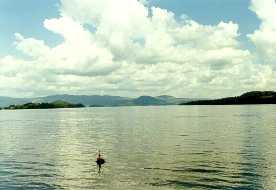
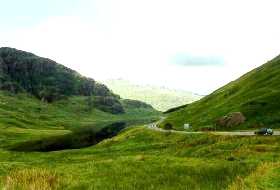 Inveraray Castle (left), on the northwestern
shore of Loch Fyne (a huge saltwater inlet) - the ancestral home
of Clan Campbell; the current castle was built in the 1740's (the
original dated from the 15th c.), and is still the home of the
current Duke of Argyll. North thru Glen Aray and along the northeastern
shore of Loch Awe to the peak of Ben Cruachan, towering (at 3694
ft) above its dam and pump storage hydroelectric power station
(right)
Inveraray Castle (left), on the northwestern
shore of Loch Fyne (a huge saltwater inlet) - the ancestral home
of Clan Campbell; the current castle was built in the 1740's (the
original dated from the 15th c.), and is still the home of the
current Duke of Argyll. North thru Glen Aray and along the northeastern
shore of Loch Awe to the peak of Ben Cruachan, towering (at 3694
ft) above its dam and pump storage hydroelectric power station
(right)
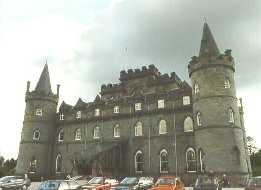
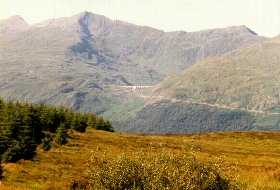 At the head of Loch Awe on a low plateau
of rock that was originally an island, the ruins of the 15th century
Kilchurn Castle (left); the lands passed from the MacGregors of
Glenstrae to the Campbells in the 14th c., from Sir Duncan Campbell
to his son Colin in 1432; the latter built the main part of the
keep, or Tower House, between 1440-1460; subsequent additions
were made thru the late 1600s; the castle was finally abandoned
in 1760. View of the harbor at the mouth of Loch Etive (right),
a long, narrow saltwater inlet from the Firth of Lorne, from the
southern shore near Connel
At the head of Loch Awe on a low plateau
of rock that was originally an island, the ruins of the 15th century
Kilchurn Castle (left); the lands passed from the MacGregors of
Glenstrae to the Campbells in the 14th c., from Sir Duncan Campbell
to his son Colin in 1432; the latter built the main part of the
keep, or Tower House, between 1440-1460; subsequent additions
were made thru the late 1600s; the castle was finally abandoned
in 1760. View of the harbor at the mouth of Loch Etive (right),
a long, narrow saltwater inlet from the Firth of Lorne, from the
southern shore near Connel
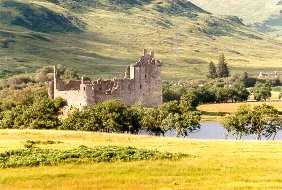
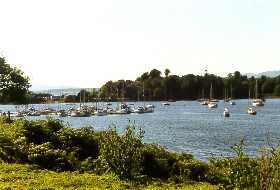 View of Oban harbor, on the Firth of
Lorne: a ferry (left) leaving for one of the many islands to the
west (among the larger: Kerrera - in the background, Lismore,
and Mull); the northern part of town (right), with the the ruins
of the 12th c. Dunollie Castle, built by Ewan, 3rd chief of the
MacDougalls, on the wooded bluff above the harbor entrance
View of Oban harbor, on the Firth of
Lorne: a ferry (left) leaving for one of the many islands to the
west (among the larger: Kerrera - in the background, Lismore,
and Mull); the northern part of town (right), with the the ruins
of the 12th c. Dunollie Castle, built by Ewan, 3rd chief of the
MacDougalls, on the wooded bluff above the harbor entrance
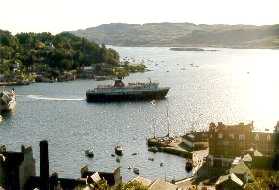
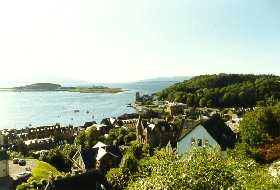 On Oban's Pulpit Hill, McCaig's Tower
('Folly'), built (but never finished) by a local banker to provide
employment for the local population during the depression of the
1890's
On Oban's Pulpit Hill, McCaig's Tower
('Folly'), built (but never finished) by a local banker to provide
employment for the local population during the depression of the
1890's
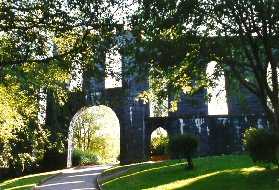
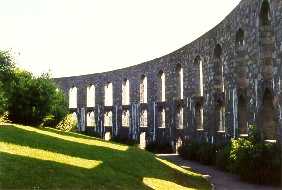 The inlet and harbor at Kentallen (left),
on the eastern shore of Loch Linnhe.
The inlet and harbor at Kentallen (left),
on the eastern shore of Loch Linnhe.
The bridge at Ballachulish, near the mouth of Loch Leven (right),
site where James (Stewart) of the Glen, falsely convicted of the
"Appin Murder" of a Campbell government official, was
hanged in 1752; his corpse was put in chains and left there for
several years afterwards as a warning to Jacobite sympathizers;
"Kidnapped," the novel by Robert Louis Stevenson, is
based on this story
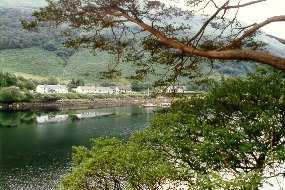
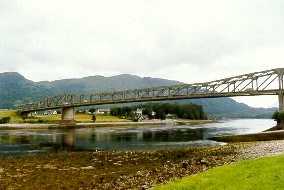 Go to Scotland-2 | Go to Scotland-3 | Go to Scotland-4
Return to Home Page
Interesting links:
Go to Scotland-2 | Go to Scotland-3 | Go to Scotland-4
Return to Home Page
Interesting links:

















